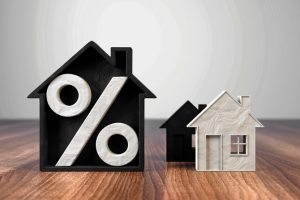At the end of June 2021, the S&P Case-Shiller National Home Price Index released its most recent numbers and the results caused analysts to employ words such as “shocking” and “extraordinary,” and to describe the U.S. housing market as being on “an absolute tear.” The reason: home prices rose 14.6% in April from year-ago levels, a slight uptick from already robust 13.3% in March. This is the fastest rate of home price growth since data collection began in 1987, and a group of economists recently surveyed held a median estimate for a year-over-year jump of 14.7%.
The numbers for individual cities are even more extreme, with Phoenix posting Case-Shiller’s most significant one-year jump at 22.3%. San Diego and Seattle followed close behind, with respective jumps of 21.6% and 20.2%. In the 20-city national price index, even at the bottom of the list, the jump in prices is still dramatic, with Chicago coming in at the bottom at a still-high 9.9%. A rise in home prices can be caused by many factors, and experts have pinpointed several during the current surge. The consensus is that price surges occurred over the last year due to record-low mortgage rates, high buyer demand, and, most glaringly, a limited supply of homes.
According to a June article in Business Insider, citing a recent report from the National Association of Realtors (NAR), “decades of chronic underbuilding left the U.S. housing market with a colossal gap between consumer demand and nationwide supply. Home sales surged to a breakneck pace after the pandemic, and the market is now under immense pressure from a lack of available units. Inventory sits near record lows, and efforts to shore up supply have been curtailed by soaring materials costs and lot shortages.” The article continues, “Countering the shortage requires a ‘once-in-a-generation response,’ the Rosen Consulting Group said in the report. Inadequate home construction over the past 20 years has left the market with an underbuilding gap of at least 5.5 million homes, it said. Contractors built 1.23 million new homes each year on average from 2001 to 2020. That’s down from the average annual pace of 1.5 million new homes from 1968 to 2000. The 5.5 million-home hole even includes the mid-2000s construction boom, which saw overwhelming home demand drive an equally strong surge in homebuilding.”

Neither the article nor the NAR study is overly optimistic about the housing shortage being solved in the near future. “Accounting for other dynamics in the housing market paints an even bleaker picture. Once losses of existing homes and underproduction relative to household formation are measured, the total supply-demand gap over the last two decades swells to 6.8 million units, according to the report. The deficit has stripped Americans of affordable homeownership, and the likely obsolescence of available homes in coming years risks exacerbating the already dire situation. Builders can still solve the problem, but the report suggests it will take a herculean effort over the next decade. Residential construction would need to accelerate to an annual pace of more than 2 million units per year. That rate would represent a 60% jump from the annual pace of roughly 1.3 million units in 2020. Data released recently signals contractors are far from reaching such a goal. Housing starts rose 3.6% in May to an annualized rate of 1.57 million units. While the data does show improvement from April, it still sits below highs seen earlier in the year and missed the median estimate for a 3.9% gain. Building permits – a proxy for future residential construction – slid to an annual rate of 1.68 million, the lowest level since October 2020 and the number of single-family units authorized but not yet under construction rose to the highest level since 2006. Taken together, the census bureau data depicts a market that’s struggling amid supply bottlenecks to shore up much-needed housing supply.”
The lack of supply is key to understanding how this current housing bubble differs from the 2008 housing bubble and subsequent crisis. In 2008, much of the housing crisis was caused by an increase in demand for mortgages, fueled by changes in underwriting standards and exotic mortgages, which allowed more people to buy homes, many of whom could not afford it. In 2021, the opposite problem exists, in that there aren’t enough homes for sale. As David Dayen writes in The American Prospect, “After the (2008) housing bubble burst, homebuilders grew extremely wary of returning to a business that had imploded so spectacularly. For the first two years after the crisis, housing starts remained below any point in the previous 40 years, and even when they rebounded, as later as the beginning of 2020, they remained at a middling level. The early months of the pandemic further cratered new home construction, and worse, set expectations for sales of components like lumber artificially low. When homebuyers did come back seeking mortgages, there just wasn’t enough lumber to physically build the homes. In the last month, unbuilt homes that have been sold but not constructed have risen by 16%. With homebuilders competing with renovators and supply chains making it hard to even acquire raw materials, this very big near-term snarl is killing new home supply.”
Owning a home was once thought to be a source of stability and happiness in the lives of many Americans, but that concept seems to be going out the window. These current trends are only going to leave millions more on the outside looking in.
Another factor impacting the American housing market is properties owned by institutional investors, such as private equity firms or hedge funds. Institutional investment began to increase following the 2008 crisis and, while not a significant factor yet in some parts of the country, its effects on homeownership are plain to see. One example of institutional investment and its effects is Invitation Homes, a $21 billion publicly-traded company that is an arm of private equity giant Blackstone. Invitation Homes operates in 16 cities, with its largest share in Atlanta, where it owns 12,556 homes as of earlier this year. While the average person usually pays a mortgage interest rate in the 2-4 percent range, Invitation homes can get billion-dollar loans at an interest rate of 1.4 %. This puts Invitation at a considerable advantage in practice because they can afford to charge an additional $5,000 to $20,000 to the purchase price of every home while getting the house at the same actual cost as a typical homeowner. Invitation Homes’ offers are almost always in cash, which is a considerable advantage in a competitive market.
To put it into perspective, Invitation Homes’ portfolio of homes is worth a total of $16 billion, and the company collects about $1.9 billion in rent per year. That means it takes about eight years of rental payments to pay back a typical house that Invitation Homes purchased. Typically, a fair price to rent ratio is assessed to be 20:1, or 20 years of rental payments to pay back the sale price. Invitation Homes specifically targets houses with the greatest potential to build wealth for the middle-class, most notably relatively affordable single-family homes built since the 1970s in metro areas. As a recent article in Slate details, investors are able to search markets scientifically and make cash offers on the most attractive properties. “Investors are depleting the inventory of the precise houses that might otherwise be attainable for younger, working- and middle-class households, in the cities where those workers can find good-paying jobs. While normal people buy houses when they actually need to move somewhere, institutional investors buy houses before a bunch of people need to move to an area.” Ultimately, this trend will make more people renters, and the United States has very poor protections for rental tenants.
In Albuquerque, the real estate market is experiencing a similar boom to most metropolitan areas around the country. In June, according to data published by the Greater Albuquerque Association of Realtors, the median home price in Albuquerque hit $305,000 – up a whopping 25.8% from June 2020. In Albuquerque, it is a similar story to the rest of the country, as increased post-pandemic demand has come face-to-face with the dwindling housing supply that faces many metropolitan areas in the United States, creating conditions for housing prices to explode. Since the Great Recession, new construction of residential dwellings in New Mexico overall has slowed dramatically. As mentioned earlier, there was great reluctance on builders and lenders to repeat the mistakes of the early- to mid-2000s when the housing supply expanded along with an increase in exotic mortgages. In New Mexico, this lack of new construction has been felt acutely, as the increase in permits for residential housing units was only 8.4% from 2015 to 2019, compared to 17.2% for the United States.
New Mexico has historically boasted a higher homeownership rate than the national average, primarily because of affordability. However, every trend in the U.S. currently is making homeownership more of a luxury than anything else. It’s becoming increasingly unattainable for the average person to purchase a home because every single factor is weighed against them. Limited home supply and institutional investment, two trends that are likely to continue, will only cause more people to be unable to participate in something that was once a staple of middle-class American life. Owning a home was once thought to be a source of stability and happiness in the lives of many Americans, but that concept seems to be going out the window. These current trends are only going to leave millions more on the outside looking in.
The good news is that housing is not the intractable problem many others seem to be. There are real solutions proposed by people who deeply care about this issue, but it’s up to society to be willing to listen. The current trend in housing is that it’s increasingly becoming consolidated in the hands of extremely powerful, wealthy people. That will be felt most painfully by the average homeowner, and we, as Americans, must not allow another basic human need to become exploited by the mega-rich.
Mark Anderson, Legal and Legislative Assistant, New Mexico Bankers Association










